The Kumano region in Wakayama Prefecture is famous for the Kumano Pilgrimage Trails that lead to the Kumano Sanzan – the three Grand Shrines of Kumano. One of them is the Kumano Nachi Taisha.
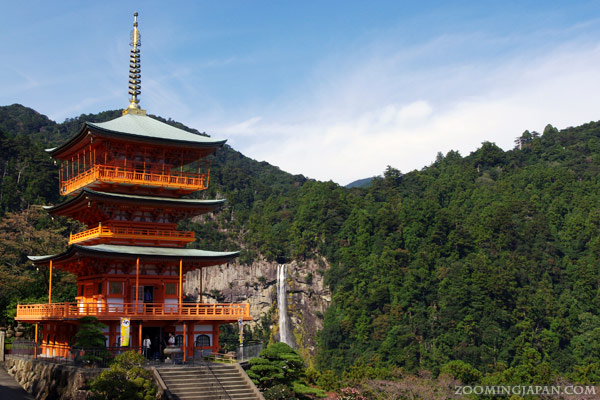
Kumano Nachi Taisha Shrine (熊野那智大社) also known as “Nachi-san” is located at a height of ~350m on Mt. Nachi on the Kii Peninsula of Wakayama Prefecture (map). Together with the other two Grand Shrines of Kumano (Hayatama Taisha and Hongu Taisha) and the Kumano Pilgrimage Trails it’s registered as UNESCO World Heritage Site.
Nachi-san is also connected through a pilgrimage path to the sacred Koya-san which is in Wakayama Prefecture as well.

Access to Kumano Nachi Taisha
There are several ways to approach Nachi Taisha. You can get off right in front of the shrine’s base (bus stop “Nachi-san”), the waterfall (bus stop “Taki-mae”) or a little bit further down at a bus stop called “Daimonzaka” (大門坂) which literally translates to “big gate slope”. This is what I chose to do and it’s the most scenic way to get to the shrine. I recommend this approach!
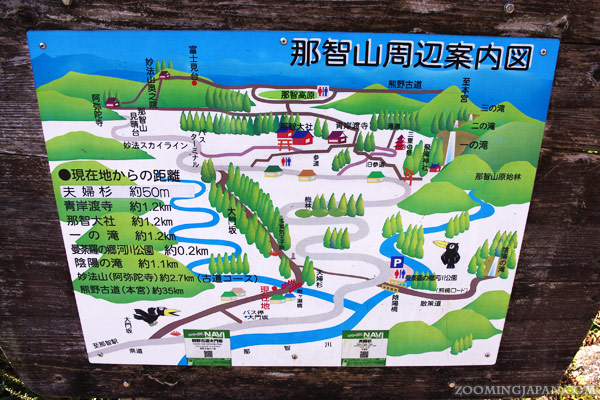
The map says it’s about 1.2km up to Kumano Nachi Taisha. If you’re short on time, then maybe you should get off in front of the shrine instead.

Some people prefer approaching wearing the original pilgrims’ clothes.

It’s also something tourists can do. You can rent a costume and take photos with Daimonzaka in the background.
In the photo above you see Becky, a celebrity on TV in Japan.

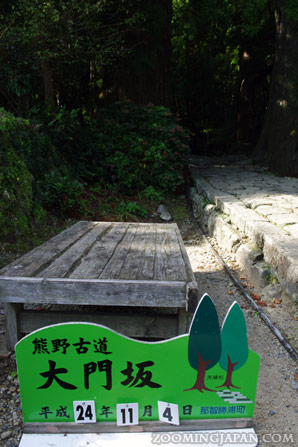
As you can see I visited on November 4th in the year 24 (Heisei 24 = 2012).

Daimonzaka is surrounded by impressive and very old cedar trees. It’s part of the Kumano Pilgrimage Trail, so you can experience walking on the original pilgrimage path. However, it’s rather short with just ~600m and 267 stairs (you can even count them if you want).
Here you can find a few maps and more information.
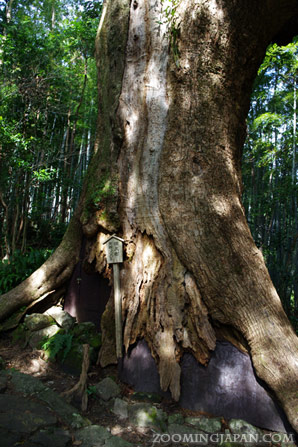
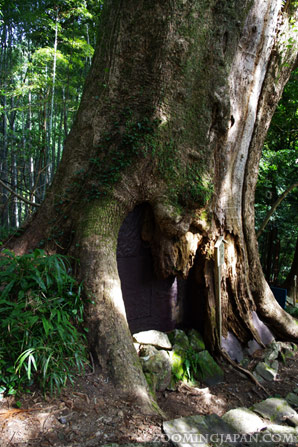
Some of the trees were really gigantic. Prepare to take much longer than you thought because you’ll stop and stare and / or take photos quite often on your way!
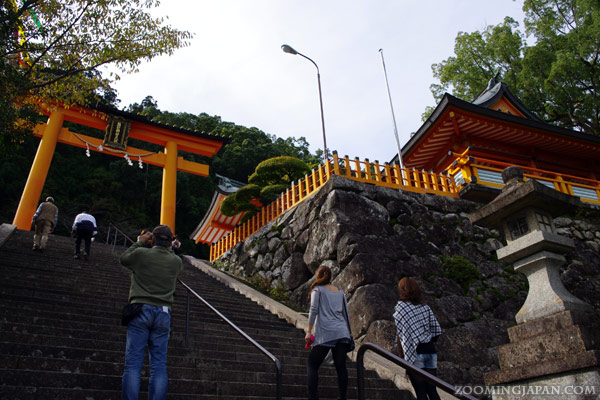
Kumano Nachi Taisha was originally built near the Great Falls of Nachi and is said to have been moved in 317 to its present location. Since ancient times people worshiped the waterfall as a deity.
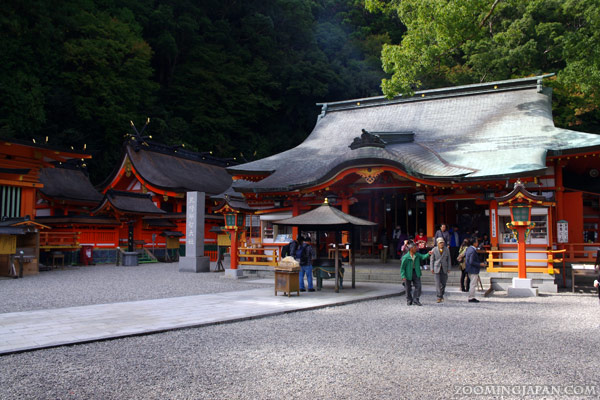
Here you can see the main hall of Kumano Nachi Taisha.
While entrance to the shrine grounds is free, there’s also a treasure hall, but you’ll have to pay 300yen.

The ema (wooden wishing plaque) of Nachi-san features the Great Nachi Waterfall.

That’s the view you’ll get once you’ve made it up to Nachi Taisha. As you can see there are a lot of stairs!
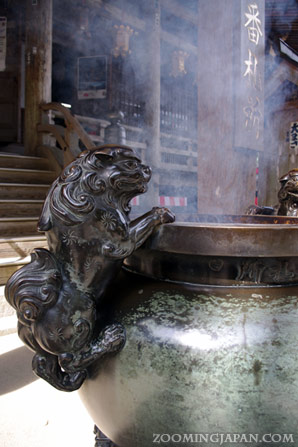

On the right you can see a photo of the shrine seal book of Kumano Nachi Taisha. As I ran out of empty pages in my old book, I bought this one. It looks great with the waterfall in the background!
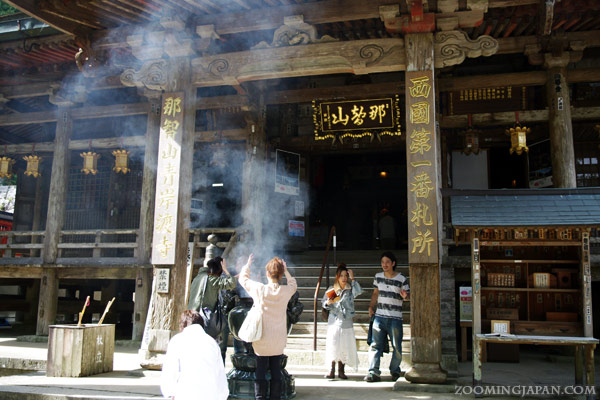
The Kumano Sanzan – the three Grand Shrines of Kumano – are connected through the Kumano Kodo Pilgrimage Trails and are apart 20-40km from each other. They all were originally strictly following Shinto traditions, but later adopted the Shinto-Buddhist fusion of deities.
Due to that fusion there are two temples that are also closely related to Kumano Nachi Taisha:
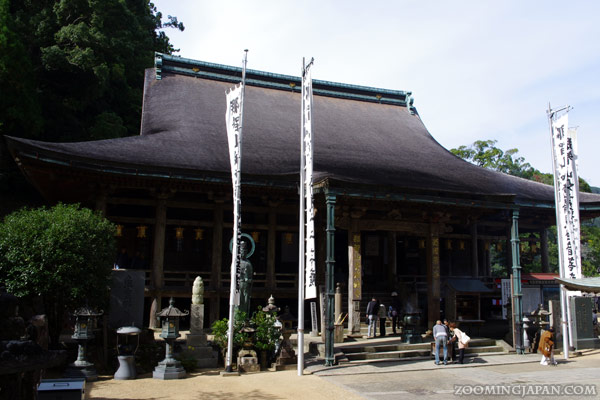
Seigantoji Temple (青岸渡寺) and Nachi Taisha are seen as one religious institution.
The temple is part of the Nachi Shrine complex and is thus one of the few Jingu-ji (shrine temples).
Originally it was founded as a Tendai Buddhist temple in the early 5th century, possibly by an Indian monk. In 2004 Seigantoji Temple was included in the UNESCO World Heritage Site “Sacred Sites and Pilgrimage Routes in the Kii Mountain Range“.
Furthermore it’s also the first stop of the “33 Temples Kansai Kannon Pilgrimage“.
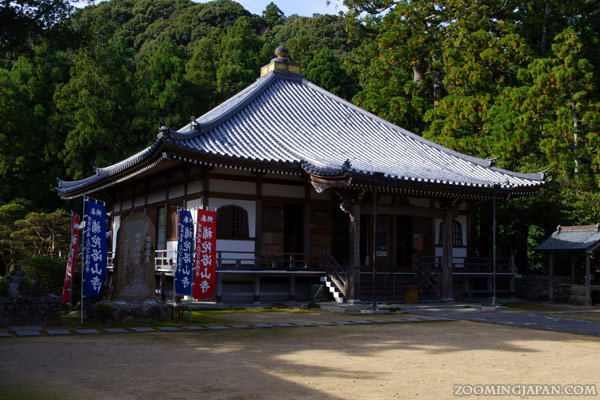
The other related temple is Fudarakusanji (補陀洛山寺) which is also a Tendai Buddhist temple. However, it’s located near Nachi Station and thus is separate from the Nachi Shrine complex.
If you access by train and get off at Nachi Station, then you can reach this temple in a few minutes. Actually you can already see it from the station!
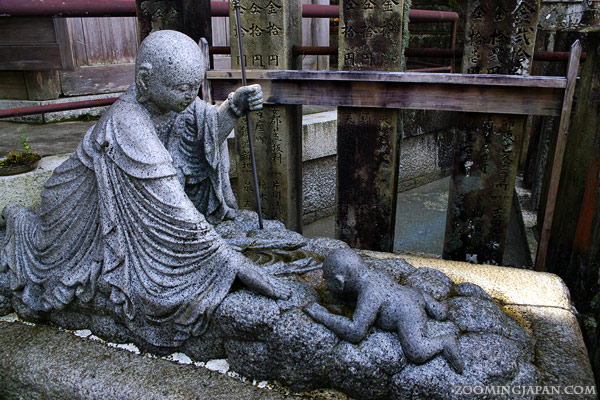
But let’s go back to the Nachi Shrine complex as there’s so much to discover like this monk statue.
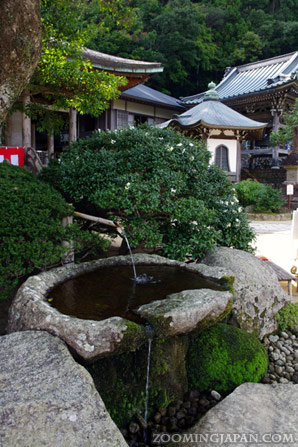
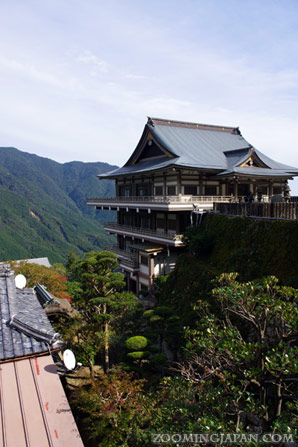
You’ll have great views from the shrine complex as it’s halfway up the mountains. From this point on you can also see the waterfall which is another ~15mins walk from there.

This is probably one of the most popular views of Kumano Nachi Taisha.
As a pagoda it isn’t really part of a shrine, but as mentioned earlier you can observe the Shinto-Buddhism fusion very well here. The pagoda is part of Seigantoji Temple.
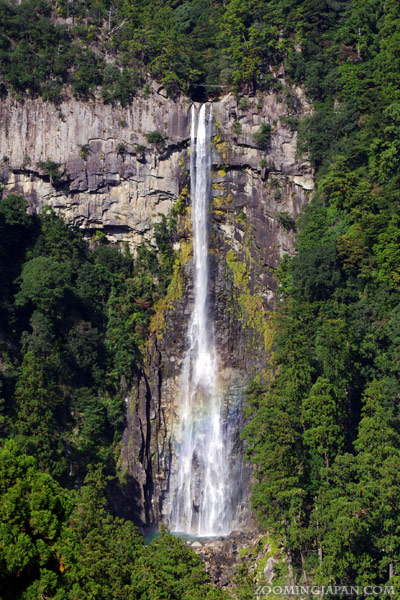
You can enter the pagoda and from the top floor you’ll have a great view of the Nachi Waterfall.

The pagoda with the waterfall in the background is the most photographed scenery of the Kumano Sanzan.
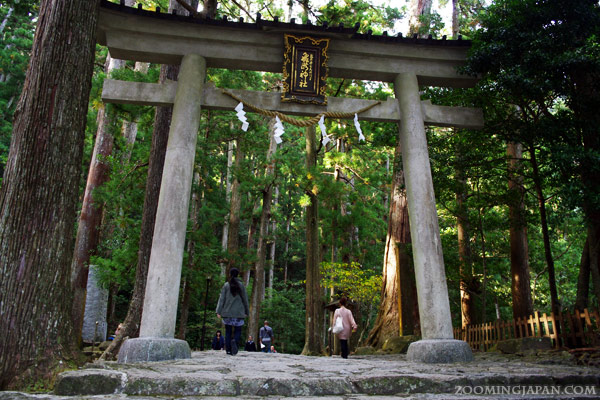
Hiryu Shrine’s gate marks the entrance to the Nachi Falls.
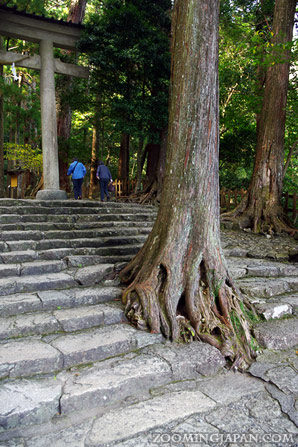
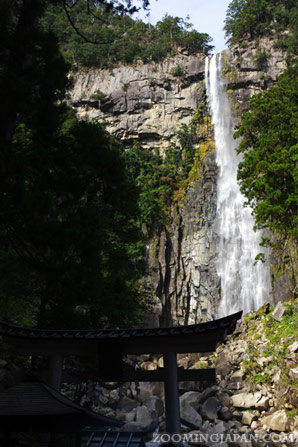
Nachi no Taki (那智滝) is the tallest waterfall in Japan (height: 133m / 400 feet; width: 13m / 40 feet).
It has been worshiped by people since ancient times. The Nachi Waterfall is believed to be inhabited by a god called Hiryu Gongen (飛滝権現).

The falls are also used for ascetic training by monks.
On July 14th the annual “Nachi-no-Hi Matsuri” (Nachi Fire Festival) is held. People celebrate the god coming back to its original place, the Nachi Waterfall. It is certainly a divine event that I’d love to see with my own eyes some day.
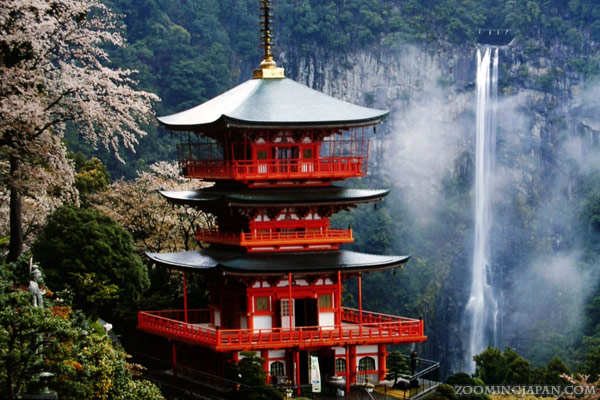
The photo above was taken in April. I found it in the information center at Nachi Station. As you can see it’s worth a visit at any time of the year!







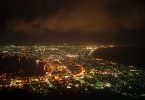

Some beautiful pictures ZJ, This is one place that I’ve been dying to see since I’ve been back in Japan. We are planning to drive there from Gifu one of these days, hopefully when it gets a little cooler :) Thanks for sharing this with us.
With a car you should be able to explore the area even more. The third of the Kumano Sanzan (Hongu Taisha) has a lot of nice onsen nearby! :)
I totally fell in love with this place, even though just from seeing your pictures :hearts:
I swear rural Japanese is my next agenda :)
I’m so glad to hear that!
Nachi was my favorite among the Kumano Sanzan after all and I LOVE when I can show people places that they want to visit after hearing about them! ^___^
A very interesting post, with lovely photos. I am always impressed by those fantastic Japanese trees.
I was relieved to see the Daimonzaka is “only” 267 steps. I would be quite able to handle that [I went up Kotohira’s 785 with no trouble, but just went down Haguro san’s 2466!].
I have been to Ise, but not Kumano, and I think, judging by what you show, that I would like to visit the place on a future trip.
I’ve been to all the sights that are connected by those pilgrim trails: Kumano Sanzan, Mt. Koya, Mt. Yoshino and Ise – and personally I enjoyed Nachi Taisha the most … maybe along with Mt. Koya! :D
I’m sure you’d love it there as well.
Hopefully you can visit during your next Japan trip.
I’ve been to lots of different parts of Japan, but never made it to Wakayama. Your posts about it, have made me determined to go on my next trip. Is it hard to get around by public transport? And what do you think is the best season to go?
BTW love your website, I always look forward to your new posts.
Hi Karina!
I’m really glad to hear that! :D
A lot of tourists ignore Wakayama Prefecture, maybe because of its more popular “neighbors” Kyoto, Nara and Osaka, but it really has to offer a few amazing sights!
And stay tuned because there’s more to come if you’re interested in things to see in Wakayama! ;P
Aww, thanks so much! ^___^
Wow you’re a cutie! Wonderful photos. :-)
Thank you! Glad you enjoyed the photos!
thank you for wonderful insight. I read the comment here, you also went to mt yoshino. I hope to know is it possible to visit Mt Yoshino and Kumano Nachi Taisha at the same day? or is it better to visit mt koya and kumano taishi in one day and mt yoshino and ninja village in iga in one day.
I’m not really into temple and castle but more to scenery view,so if im went to Koyasan, is it possible to finish touring koya san area in about half day? I will visiting japan early next month but because it only a short 5 full day holiday,i wish to maximize my time to visit the place to view autumn foliage as much as possible. My priority would be touring wakayama and nara but if it possible to squeeze my day at wakayama,i hope to include Biwa-ko and Hikone
Sorry if i’m asking too many question
Hi Mel!
No, I think you got that wrong. I went to Nachi Taisha, Hongu Taisha and Hayatama Taisha on two days. Maybe if you have a car, you can do all three in one day. They are all in the Kumano region of Wakayama Prefecture.
Mt. Yoshino, on the other hand, is in Nara Prefecture. It’s impossible to do that together in one day with any of the Kumano Sanzan!
Mt. Koya is in Wakayama Prefecture, but you’ll probably need a whole day for that alone.
5 days is really short. It also depends on the means of transporation. Will you have a rental car?
Getting to Mt. Koya takes quite a long time, so together with transportation it’ll be a daytrip.
Hikone Castle can be done in half a day and together with Lake Biwa.
Mt. Yoshino is only really interesting during cherry blossom season, so you might want to skip it.
owh.. ok..thanks a lot.. i need to rearrange my trip then.i will only use public transport and rent a car is not an option to me.
I have this strange habit of hating crowded place,so i maybe skip either one,Mt.Koya or Kumano since both of them really famous and will be full of tourist. i only can handle one and going both is like kill my reason for relax and enjoy the nature.
i will be going to japan from 1st to 6nov.i already done my research and it seem that its too early for autumn foliage at kansai region except for some part like Mt Yoshino. after reading your reply,i think i maybe need to find other spot. yes, i admit 5 day is really short but its the only time i can afford. i have use up almost all my annual leave for my japan trip last may.
As for places being crowded it also depends WHEN you go. Unfortunately there’s a long weekend (Nov 2nd – 4th), so no matter where you go, it might be very crowded, I fear! :(
I suppose that the Kumano region is less crowded than Mt. Koya, though.
When I visited Mt. Koya on November 5th the autumn colors were already out (as it’s quite high there).
However, this year has been unusually hot, so I’m not sure if it’ll be the same.
Good luck and I hope you’ll enjoy your trip! :D
thanks a lot dear, your opinion really helpful for me to rearrange my journey.i think i will go to koyasan and skip kumano.hopefully there will be next time for me to spend ample time to appreciate the beauty of kumano sanzan. :teary:
I dont know 4th also a holiday in japan,if i know i will make it at least a week later.. sigh,i really bad with timing..anyway i will still going to yoshino because after read other blog,i totally convince thats my type,clear blue river with waterfall,bridge across mountain and a view of multiple mountain peak
I’m sure no matter what you decide to do in the end, you’ll enjoy your time in Japan! :D
[…] Für einen kleinen Überblick, wie man mit öffentlichen Verkehrsmitteln reist, empfehle ich den Artikel auf Zoomingjapan.com über Kumano Nachi Taisha. […]
I love your last picture! Im going to Japan in Mar/Apr and after finding your post i am going to make a trip here! Could you share with me the point from which you took that picture? i would love to see that same view!
Cheers and thanks in advance!
The last photo was a photo of a poster I found there. I don’t think it’s possible to shoot something like that yourself. It also looks like they somehow zoomed the waterfall closer to the pagoda than it actually is. ;)
Hello. I plan to go to the Falls on April. What time is the best to visit the Falls? Is it in the morning? Or afternoon? Or maybe sunset?
Thank you
Hi Antonius,
As I’ve only been there once (in the afternoon), I’m not sure.
But I liked it quite a bit there in the afternoon, so maybe I would recommend that time of the day. :)